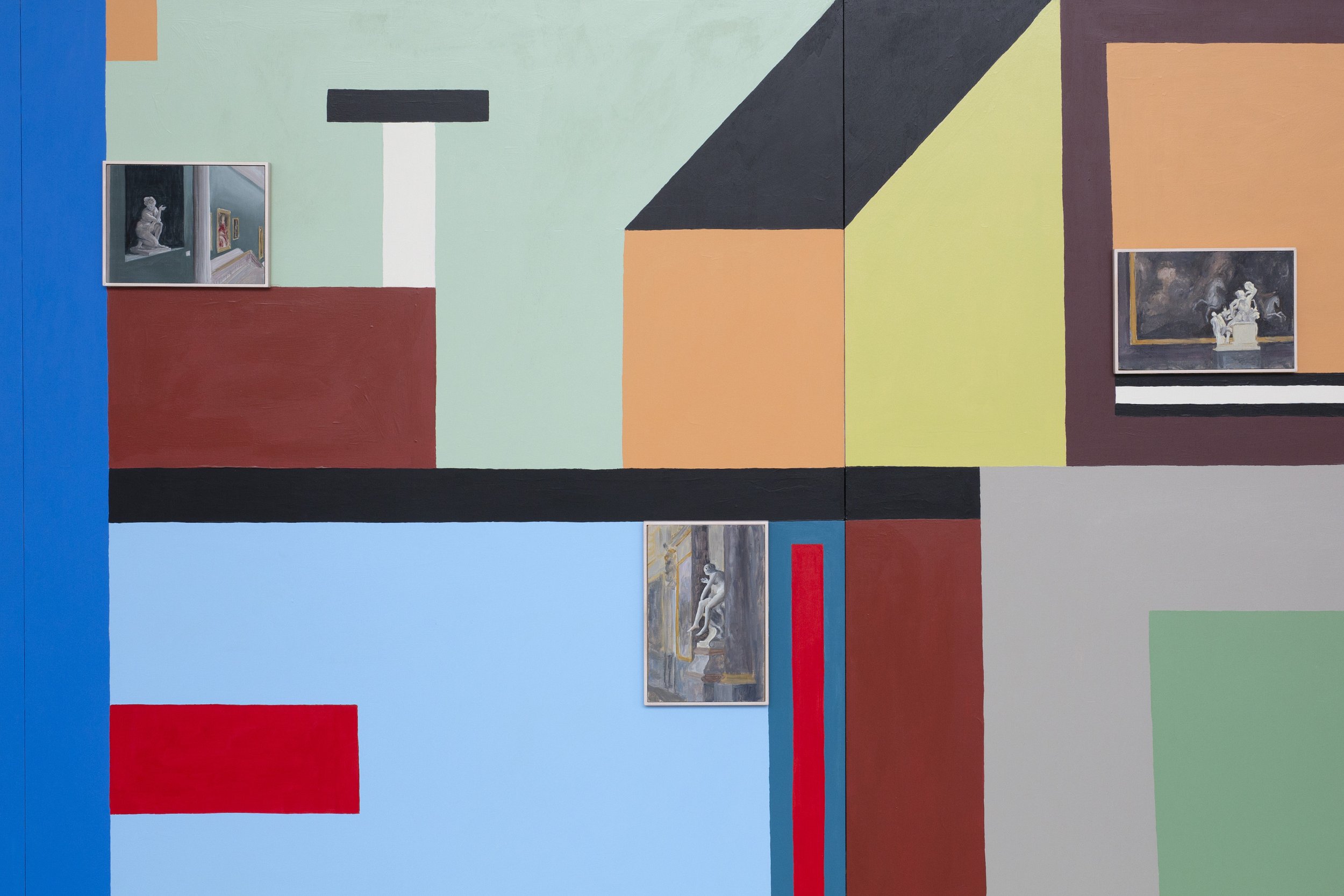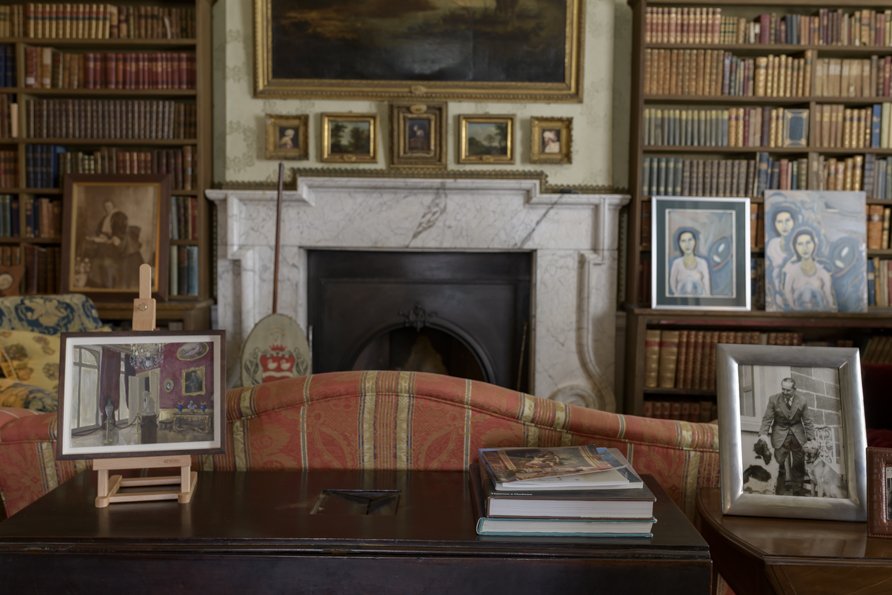Assab One presents in Studio 3 a solo exhibition by Eithne Jordan entitled Messi in Scena, staged in dialogue with a site-specific installation by Nathalie du Pasquier.
The exhibition is the result of the conversation the Irish artist and Nathalie Du Pasquier have been nurturing over the years and a relationship made up of mutual esteem and friendship taking shape for the first time in Assab One’s newly renovated space.
Eithne Jordan’s works on view explore the relationship between art objects and their display in museums and institutions, with a particular focus on buildings of the XXVIII and XIX centuries.
Nathalie Du Pasquier’s installation is designed to place the Irish artist’s small-scale works, and invites further exploration of the relationship between the art exhibition and the surrounding space. Larger works investigating the same theme will be set up on the walls.
26th February - April 5th 2023
Supported by:









-
Nathalie Du Pasquier was born in Bordeaux (France) in 1957. She has lived in Milan since 1979. Until 1986 she worked as a designer and was a founder member of Memphis. In 1987, painting became her main activity.
Some recent exhibitions: 2022: Campo di Marte, MRAC, Serignan, France; Chex Eux, Villa Savoye, France; 2021: Campo di Marte, MACRO, Rome.
Further information on her work can be found at www.nathaliedupasquier.com
-
A conversation between Eithne Jordan and George Sowden
You live in Ireland and in France, does your daily routine change between the two locations?
My working day is the same in both places. I go for an early walk first, then into my studio for the day. In Dublin, because it is my native city, I have a busier cultural and family and social life. In France I live in a small but thriving village, in a big old house that I can disappear into for my work, and beautiful countryside for walking – a quieter rhythm of life.
I read that you take photographs of places that interest you and use a photographic image as a starting point for a painting. In fact, you make the painting of a photographic image of reality, but it is you who chooses the subject, the framing in the camera, the time of day, the season of the year, etc. Then it is your skill as a painter, your sensitivity, that transforms the image, still recognizable, into something mysterious, enigmatic, special.
Would you agree with this or do you see your intervention in a different way?
I think that is a good description. The paintings are not documents of places or buildings or museums, although they all come from real places that I have photographed. I must visit the places myself, and take my own photographs. The photos have to speak to me on a level where there is the potential to contain more than the sum of its parts. They only work if they can have this quality of becoming an emotional or psychological space to enter into, and that transformation happens in the painting process.
Yes, your paintings are representation of places you have visited. The cityscapes I gaze at and drift into the details and imagine all kinds of things and have overlapping thoughts. They evoke memories, give me feelings but I don’t ask question, I simply look and enjoy the pleasure of the poetry. In the museumscapes I wander around for a while but I cannot stop asking myself, why interiors of museums?
All my paintings are emotional landscapes, including the cityscapes that have no people in them! They are spaces for something to happen, like a stage set. These museum interiors are spheres of theatre in a way and using the sculptures is a way of introducing the human figure at many steps removed. In my paintings of these sculptures and paintings I can use the figure as a carrier of feeling/emotion, rather than as a portrait of a person. The museum is a rich setting for playing with. There are lots of layers – the spaces in the museum – often beautiful rooms, and the display decided by the museum curator, and of course the artworks themselves, how they speak to each other and the viewer.
When did you first met Nathalie?
I first met Nathalie in Dublin, I can’t remember the year exactly, around 2007, I think. We were both showing with the wonderful Rubicon Gallery in Dublin at that time. So, I knew her work already, and I loved those big still life paintings from that time, they had a directness and clarity and elegance I hadn’t seen before in painting. I’d also heard a lot about her through our mutual friends the painters Richard Gorman and Stephen McKenna. So, when we finally met, we instantly became friends.
Nathalie is a painter, she is not a conceptual artist, she will explain her work as a result of doing it. You also are a painter; you create things which evoke feelings and thoughts. What would you add to this?
I’ve always liked Nathalie’s approach to paintings, which is as you say through the making rather than the concept. There are similarities in this aspect of our work. And like me, Nathalie creates worlds and spaces, though in a totally different way, and much more physically present and enveloping. She has a vast command of materials, forms and mediums, equally at home no matter what she does. I am limited to being only a painter – my world is a two dimensional one, my medium is paint, and I create illusions of spaces rather than real physical space. You and Nathalie decided on her contribution to your exhibition. It is not a joint exhibition and Nathalie has been very clear to me that the exhibition is yours and her work is a setting for some of your paintings.
Is a ‘setting’ the best way the describe her contribution?
I like the word “setting”. But it is a modest way to describe these very beautiful structures with beautiful painting of Nathalie’s, that sets up a conversation with my paintings. I am so happy to see this work, this setting, and so excited to see how my little paintings react with it, how the two worlds respond to each other.
Questions George Sowden* – Replies Eithne Jordan
January 2023
*George Sowden, designer, lives and works in Milan.
-
Assab One is a non profit organisation founded by Elena Quarestani that aims at providing artists with a non-conventional environment for research and expression. Assab One produces and promotes exhibitions, events and art projects focusing on initiatives that integrate different languages capable of reaching beyond the art world.
More information can be found on their website www.assab-one.org
-
OPENING HOURS March 1 through April 5 Wednesday through Friday from 3 p.m. to 7 p.m.
INAUGURATION Opening Sunday, Feb. 26 from 4 p.m. to 7 p.m.
Free admission with Assab One 2023 card (€10). For more information write to info@assab-one.org
Free access with 2023 membership card (€10)
















